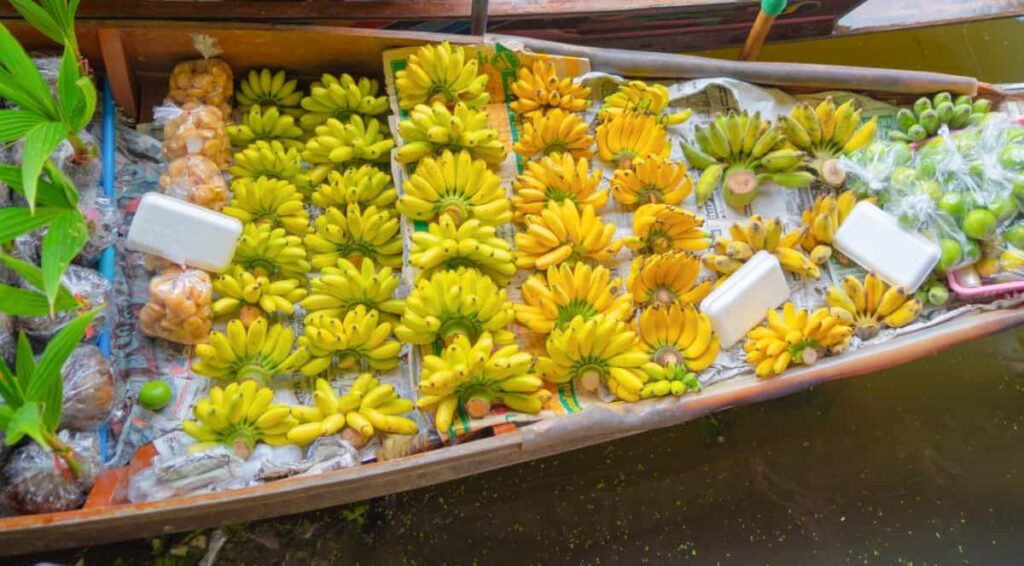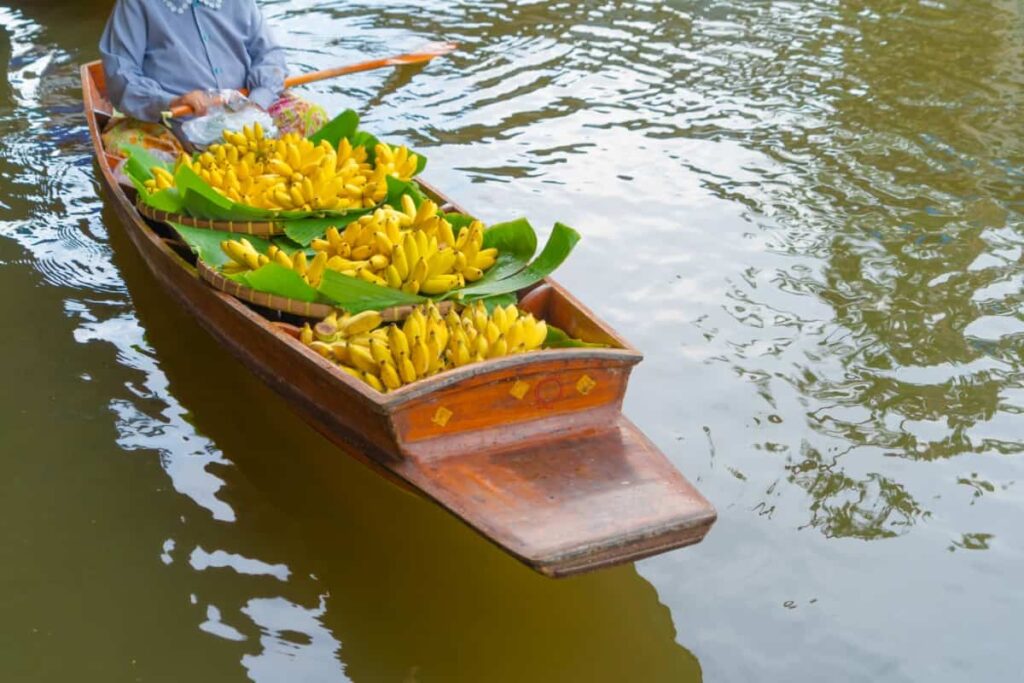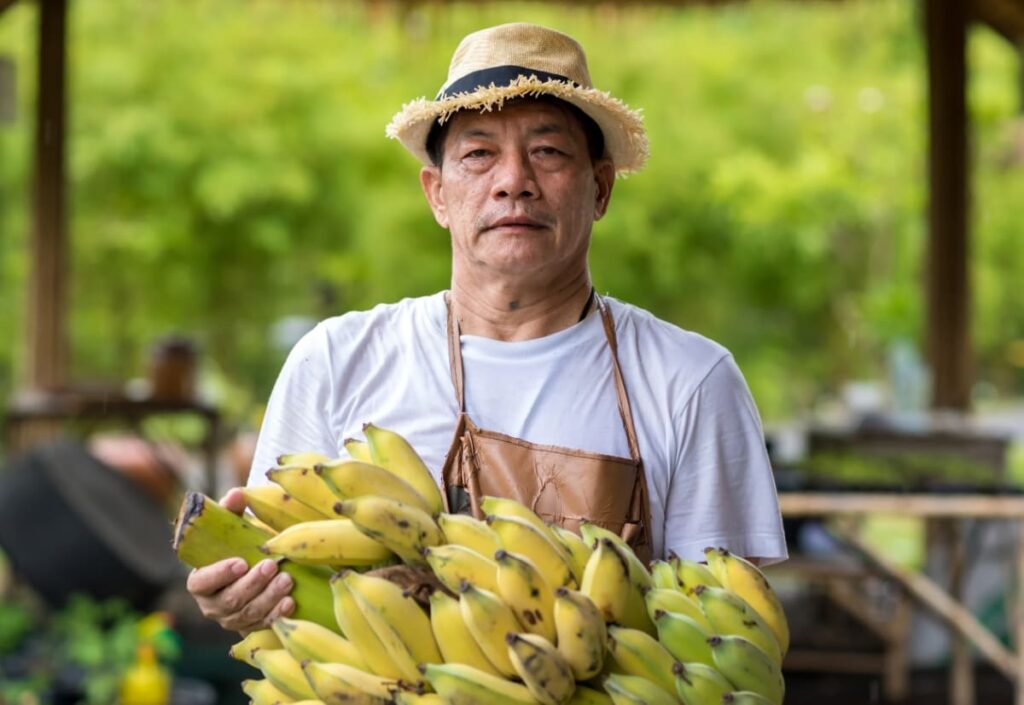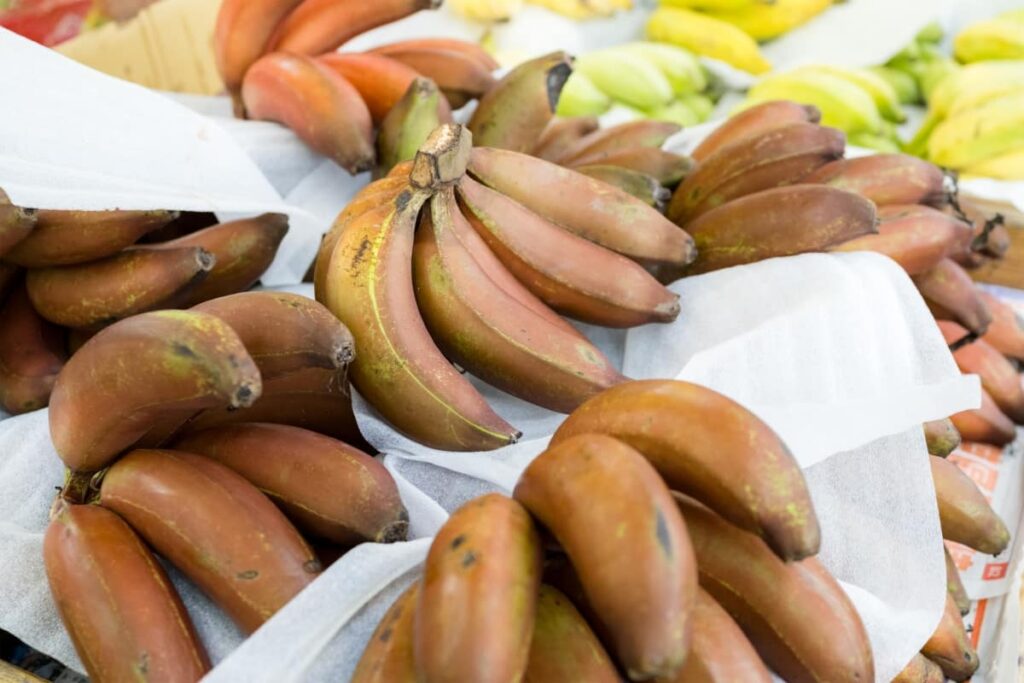Thai Banana Cultivation holds great importance for both the farmers and consumers alike. For farmers, it provides a lucrative opportunity to earn a sustainable income and support their livelihoods. Thai Banana cultivation is a fascinating practice that involves the cultivation and harvesting of various Banana varieties in Thailand. Thai Bananas are known for their unique appearance and delicious taste, making them popular both locally and internationally.

Thai Banana Cultivation
How to Grow Thai Banana Plants
Thai Banana plants are relatively easy to grow, making them a popular variety for gardeners and farmers alike. Select a spot in your garden or farm that receives plenty of sunlight daily. Thai Bananas thrive in warm climates with temperatures between 27-32°C. Prepare the growing soil by adding organic matter to improve its drainage.
Place the young Thai Banana plant into the hole and then backfill it with soil, ensuring that it is packed around the roots. Regular watering is important for healthy growth, especially during dry periods. Fertilize regularly using a balanced fertilizer high in potassium and phosphorus to promote fruit production. Prune any damaged or dead leaves periodically to maintain a tidy appearance and remove any potential disease vectors.
Types of Bananas Grown in Thailand
Thailand’s Bananas are a delightful mix of shapes, sizes, and colors. There are mainly 4 main Banana varieties that are common to all fruit markets in Thailand.
- Kluai Hom or Fragrant Banana: As the name suggests, these Bananas have a delightful aroma and a slightly tangy flavor. They are commonly used in desserts and can be enjoyed both ripe and unripe.
- Kluai Kai or Egg Bananas: These small-sized Bananas resemble eggs, hence the name. They have a sweet flavor, making them perfect for snacking or adding to smoothies.
- Kluai Nam Waa: This variety is often referred to as the “apple Banana” due to its crisp texture and subtly tart taste. It is commonly eaten raw or used in salads.
- Kluai Had Mook: Also known as “Honey Bananas,” these yellow-skinned fruits have a rich sweetness that intensifies as they ripen. They are often enjoyed on their own or incorporated into baked goods.
Where to Find Bananas in Thailand?
The tropical climate of Thailand provides ideal conditions for Banana cultivation, ensuring abundant yields. The top spot for Banana lovers is the famous Mae Wang District in Chiang Mai province. Known as the “Banana Capital,” this area boasts vast plantations that grow a variety of Bananas, such as Namwa, Kluai Khai, and Gluay Hom Thong. The picturesque scenery combined with the sweet aroma of ripe Bananas makes it a must-visit destination. Another great place to find Bananas is Nakhon Pathom Province, particularly at Don Wai Floating Market.
How to Eat Thai Banana
One popular method is to peel the Banana and bite it directly. The creamy texture makes for a delicious snack on its own. Another option is to slice the Banana and add it to fruit salads or smoothies. The natural sweetness of Thai Bananas pairs well with tropical fruits like mangoes and pineapples, creating a refreshing treat.
In case you missed it: How to Increase Banana Yield: Exploring Boosting Techniques for Fruit Size, Quality, and Yield

Thai Banana Price
The price of Thai Bananas in Thailand can change based on various factors such as location, season, and market demand. However, on average, you can expect to find Thai Bananas priced at around 20-30 Baht per kilogram. In local markets or street stalls, you may even find them being sold for as little as 10 Baht per kilogram during peak seasons when supply is abundant.
Challenges and Opportunities in Thai Banana Farming
The major challenge is the threat of diseases and pests that can wreak havoc on Banana plantations. The most common disease affecting Thai Bananas is Panama disease, which can lead to significant crop losses if not properly managed. Another challenge is climate change and its impact on weather patterns. Erratic rainfall, extreme temperatures, and changes in growing seasons can all affect the health and productivity of Banana plants.
Additionally, access to water for irrigation purposes can be a challenge in certain regions. Without sufficient water supply, farmers may struggle to maintain optimal growing conditions for their crops. Technology advancements have opened up possibilities for improving cultivation techniques and increasing yields. The government’s support through various initiatives, such as subsidies or training programs, provides opportunities for farmers to improve their knowledge about sustainable farming practices.
Market Trends and Demand for Thai Bananas
Thai Bananas have been gaining popularity in recent years due to their unique flavors and versatility. The market trends show a steady increase in the demand for Thai Bananas, both domestically and internationally. Additionally, the health-conscious population is also driving up the demand for Thailand’s Banana production. These Bananas are packed with vitamins and minerals, making them a nutritious snack option.
They are also low in calories and fat-free, which appeals to those looking to maintain a healthy lifestyle. Furthermore, as consumers become more aware of sustainable farming practices, there has been an increased focus on supporting local farmers who cultivate Thai Bananas. On the international front, Thailand’s reputation as a leading exporter of high-quality fruits has further boosted demand for its Bananas.
Government Support and Regulations for Thai Banana Farming
The government of Thailand recognizes the importance of the Banana industry and has implemented various support measures to ensure its growth. They have established regulations to maintain quality standards, promote sustainable farming practices, and protect the interests of both farmers and consumers.
One such initiative is the provision of financial assistance to Banana farmers in Thailand through subsidies and grants. This helps them invest in modern technology, irrigation systems, and machinery that improve productivity and reduce production costs. They also conduct training programs for farmers on best agricultural practices to enhance yield and quality.
In case you missed it: Cavendish Banana Farming in the Philippines: Cultivation Practices

To ensure fair trade practices, regulations have been put in place for export certification, packaging standards, labeling requirements, and pest control measures. These regulations help maintain consistent quality throughout the supply chain while safeguarding consumer health. Moreover, the government collaborates with international organizations to establish global trade agreements that benefit Thai Banana exporters. This opens up opportunities for increased market access and boosts export competitiveness.
Export and Import of Thai Bananas: An Overview of the Global Trade
The export and import of Thai Bananas play an important role in meeting the demand for this tropical fruit worldwide. Thailand is one of the leading exporters of Bananas, with countries like China, Japan, South Korea, and Europe being its major importers. The global trade of Thai Bananas has witnessed significant growth over the years due to their high quality and appealing flavor.
One reason behind the success of Thai Banana exports is the country’s favorable climate for cultivation. The international demand for Thai Bananas stems from their versatility in various culinary applications. In recent years, there has been an increasing trend towards organic produce globally. To facilitate smooth trade operations, governments play a vital role by implementing regulations and standards related to packaging, handling procedures, and transport protocols.
Thai Banana Farming Profit
With the high demand for Thai Bananas both domestically and internationally, farmers have a lucrative opportunity to make a substantial income. The profit margins in Thai Banana farming can change based on many factors, such as the size of the plantation, cultivation techniques employed, market conditions, and government support.
With an average yield per rai (a unit of land measurement) reaching around 5-8 tons, farmers have the potential to generate significant revenue. Considering that one rai is equivalent to approximately 1,600 square meters or about half an acre, you can imagine the scale at which these profits can accumulate. The Banana is ready in 8-9 months, so every 8 months, the plantation yields 100-150,000 Baht profit.
Frequently Asked Questions (FAQ) on Thai Banana Cultivation
What is the Difference Between a Thai Banana and a Regular Banana?
Thai Bananas, also known as “Kluai Namwa,” are smaller in size compared to regular Bananas but packed with more flavor. They have a sweeter taste with hints of tanginess that make them incredibly delicious.
How Long Does It Take for Thai Banana Plants to Bear Fruit?
It usually takes around 8-9 months for the plants to produce fruit after planting.
Can I Grow Thai Bananas in Containers or Pots?
Yes, you can grow Thai Bananas in containers as long as they have enough space and proper drainage.
When is the Best Time to Harvest Thai Bananas?
Harvesting should occur when the fruits have fully developed but are still green before ripening on the plant itself.
In case you missed it: Banana Farming Information Guide

Conclusion
Thai Banana Cultivation plays a vital role in preserving biodiversity by promoting the growth of diverse Banana varieties indigenous to Thailand. This helps maintain genetic diversity within the Banana species and safeguards against diseases that may arise from monoculture farming practices. The cultivation of Thai Bananas contributes significantly to the local economy through job creation and export opportunities.
- Management Pests and Diseases in Your Cotton Field
- Sheep Farming Business Plan for Beginners
- Aquaponic Farming at Home: A Step-By-Step Guide
- Profitable Village Farming Business Ideas in 2024
- High-Yield Aquaculture: Fast-Growing Fish for Farming
- Effective Fish Pond Construction Techniques for Beginners
- Irrigation and Water Management in Pineapple Farming
- Blossom to Harvest: Mastering Flowering and Pollination in Papaya Farming
- Pig Fattening Essentials: From Selection to Sale for Beginners
